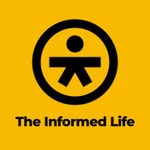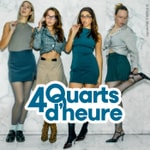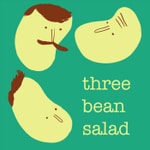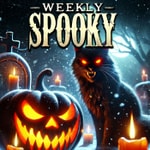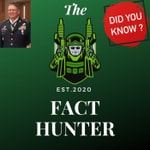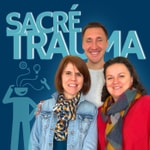Queer Lit – Détails, épisodes et analyse
Détails du podcast
Informations techniques et générales issues du flux RSS du podcast.

Queer Lit
Lena Mattheis
Fréquence : 1 épisode/11j. Total Éps: 127

New episode every other week!
Recent transcripts here: https://lenamattheis.wordpress.com/queer-lit-transcripts/
queerlitpodcast@gmail.com
https://lenamattheis.wordpress.com/queerlit
Twitter and Instagram: @queerlitpodcast
Music by geovanebruny from Pixabay
Classements récents
Dernières positions dans les classements Apple Podcasts et Spotify.
Apple Podcasts
🇬🇧 Grande Bretagne - books
10/03/2025#71🇫🇷 France - books
18/02/2025#91🇩🇪 Allemagne - books
29/12/2024#74🇬🇧 Grande Bretagne - books
05/11/2024#97🇫🇷 France - books
22/10/2024#86🇫🇷 France - books
19/10/2024#100🇬🇧 Grande Bretagne - books
17/10/2024#72
Spotify
Aucun classement récent disponible
Liens partagés entre épisodes et podcasts
Liens présents dans les descriptions d'épisodes et autres podcasts les utilisant également.
See all- https://gmail.com
6277 partages
- https://blacklivesmatter.com/
418 partages
- https://mermaidsuk.org.uk/
399 partages
- https://www.instagram.com/motaz_azaiza
218 partages
- https://www.instagram.com/wizard_bisan1
210 partages
Qualité et score du flux RSS
Évaluation technique de la qualité et de la structure du flux RSS.
See allScore global : 64%
Historique des publications
Répartition mensuelle des publications d'épisodes au fil des années.
“Queering Desire” with Róisín Ryan-Flood and Amy Tooth Murphy
mardi 15 octobre 2024 • Durée 53:50
References:
Holding Hands: Experiences of shame, pride and protest among LGBT relationship partners
Centre for Intimate and Sexual Citizenship
https://www.essex.ac.uk/centres-and-institutes/intimate-and-sexual-citizenship
Notches
Esther Newton
Sally Munt
Anne Lister
Les Feinberg
Billie Eilish
Charli XCX
Eleanor Medhurst
Sarah Joy Ford
Susan Stryker
Rosalind Gill
Kimberley Mather
Mie Astrup Jensen
El. Reid-Buckley
Phoebe Kisubi Mbasalaki
Liz Millward
Marie Lou Duret
Prudence Bussey-Chamberlain #
Ken Plummer
Agnes
Ella Ben Hagai
Dominique Adams-Santos
Skala Eressos
Sappho
Sadie Lee
Libro Levi Bridgeman’s The Butch Monologues
Jack Halberstam’s Female Masculinities
Ladies of Llangollen
José Esteban Muñoz
K. Allison Hammer
Gay’s The Word
Esther Newton’s My Butch Career
Boots of Leather, Slippers of Gold
Patricia Highsmith’s Carol (The Price of Salt)
The Talented Mr Ripley
Andrew Scott Alfred
Hitchcock Strangers on a Train
Lillian Faderman’s Surpassing the Love of Men
Grace Ellis’ Flung out of Space
Questions you should be able to respond to after listening:
- The editors speak a lot about interdisciplinarity and their respective backgrounds in the humanities and in sociology. Which challenges and benefits of working across disciplines do they mention? Can you think of others?
- Another important thread is queerness across different generations. How do you experience queer kinship across generations? What do you think the term ‘queer lineage’ might mean?
- What might femme theory be? Please look up the term and see what you find.
- What do the editors say about online and physical queer space?
- Which essay of Queering Desire are you going to read first and why?
“Queering French Fairy Tales” with Mélie Boltz Nasr
mardi 1 octobre 2024 • Durée 31:36
References:
Skala Eressos
Sappho
Contes D’Un Autre Bois
https://www.editions-ixe.fr/catalogue/contes-dun-autre-bois/
Charles Perrault
Grimm brothers
Walt Disney
Hassan Abdulrazzak’s Laila Pines For The Wolf
https://medium.com/@abdulrazzak/laila-pines-for-the-wolf-3710e81ebbd0
Éditions iXe
Bye Bye Binary
https://typotheque.genderfluid.space/fr
@bye.byebinary
BBB Baskervvol
Glyph
Alpheratz
Ursula Le Guin “Is Gender Necessary? Redux”
https://theanarchistlibrary.org/library/ursula-k-le-guin-is-gender-necessary-redux
Aesop
Lettre Aux Copaines
https://lettre-aux-copaines.kessel.media/posts
Questions you should be able to respond to after listening:
- What might the political framework of your favourite fairy tale be?
- Have you ever used an inclusive font? What do you think of this idea?
- What is an example of feminist grammar in your native language?
- Do you think nonbinary language is political? What is its place in creative practice?
- If you were to invent a nonbinary font, what would it be called?
“Narrating Palestine” with Nora Parr
mardi 11 juin 2024 • Durée 41:31
Learn more about Nora’s work by following @noraehp on Instagram!
References:
Novel Palestine: Nation through the Works of Ibrahim Nasrallah (2023) by Nora Parr
Susan Lanser
Narrative Conference (ISSN)
https://www.thenarrativesociety.org/2024-conference-1
The Palestine Trauma Centre
https://www.palestinetraumacentre.uk/
Nakba
Road to Beersheva by Ethel Mannin (to see how some Arab critics received her work see this translation in the Journal of Arabic Literature https://doi.org/10.1163/1570064x-12341510)
Bab al-Shams (trans. as Gate of the Sun) by Elias Khoury
Children of the Ghetto series
https://rayaagency.org/book-author/khoury-elias/
Don’t Look Left: Diary of a Genocide by Atef Abu Saif, translated and published by Comma Press in Manchester
Ellipses (the first instance that really got Nora thinking is addressed in chapter 4 of the book Novel Palestine, page 77 has an image of the ellipses in question!) https://luminosoa.org/site/books/10.1525/luminos.168/read/?loc=001.xhtml
This article looks the problem of ‘eloquent silence’ from a different angle.
https://archiv.ub.uni-marburg.de/ep/0003/2018/229/7792/
Minor Detail by Adania Shibli
J.M. Coetzee (writing on this is in a forthcoming chapter in Teaching Politically from Fordham Uni press, eds May Hawwas and Bruce Robbins)
https://www.gazapassages.com/
https://www.instagram.com/wizard_bisan1/
https://www.instagram.com/motaz_azaiza/
https://www.instagram.com/omarherzshow/
The Tale of a Wall by Nasser Abu Srour
Maya Abu Al-Hayat
Memory of Forgetfulness by Mahmoud Darwish
Maria Sulimma
Trees for the Absentees by Ahlam Bsharat
Rights4Time
https://rights4time.com/nora-parr/
Questions you should be able to respond to after listening:
- Throughout the podcast, Nora mentions how genre and genre expectations (for YA literature, science fiction, and serial narratives, for example) impact how we perceive narratives. Do you have an example for this?
- What does Nora say about the temporal structure of trauma and storytelling?
- What might the study of narrative have to do with mental health?
- Which narratives can social media convey about everyday life in Gaza? Which examples does Nora give?
- How willing are you to engage with narratives that are uncomfortable?
“Trans Childhood” with Jules Gill-Peterson
mardi 12 octobre 2021 • Durée 53:10
Works and People mentioned:
Jules Gill Peterson’s Histories of the Transgender Child
“Dissociation as Trans Method II”
https://sadbrowngirl.substack.com/p/dissociation-as-trans-method-ii?justPublished=true
Joanne Meyerowitz
Susan Stryker
Rousseau’s Émile, or On Education
Magnus Hirschfeld
Kathryn Bond Stockton’s Making Out
Female Mimics
Leslie Feinberg’s Transgender Warriors (and Stonebutch Blues)
Find out more about the incredible Jules on her website (https://www.jgillpeterson.com/) or on Twitter (@gp_jls). Or, you know, find much less interesting content here (@Lena_Mattheis) on Instagram or Twitter.
Questions you should be able to respond to after listening:
1. Why does Jules think that the concept of childhood is potentially more revelatory to think about than a definition of transness? How do trans children subvert hierarchies established through Western ideas of childhood?
2. Why are children unknowable? What does ‘unknowable’ mean?
3. How is the idea of childhood and immaturity used in a colonial context or to justify incarceration?
4. What does Jules mean when she says that “we really overinflate the power of signs”?
5. Have you ever known something about yourself despite not having a word to describe it? Can you think of an example for this from queer literature?
6. How can our perspective as literary studies scholars help us reflect on the production of self-knowledge?
“Queer Cities“ with Davy Knittle
mardi 28 septembre 2021 • Durée 44:24
Texts and people mentioned:
Karen Tongson, Relocations: Queer Suburban Imaginaries (NYU Press, 2011)
Robert McRuer, “Compulsory Able-Bodiedness and Queer/Disabled Existence” in Disability Studies: Enabling the Humanities, edited by Sharon L. Snyder, Brenda Jo Brueggeman, and Rosemarie Garland-Thomson. Modern Language Association of America, 2002. 301-308.
George Chauncey, “Privacy Could Only Be Had in Public': Forging a Gay World in the Streets” in Gay New York, Basic Books, 1994. 179-205.
Julie Abraham, Metropolitan Lovers: The Homosexuality of Cities (University of Minnesota Press, 2009)
Trans Wellness Conference: www.transphl.org (@TransPHL)
Thomas Hobbes
Calvin & Hobbes
Eileen Myles, “Hot Night” in Not Me (Semiotext(e), 1991).
Richard Florida, Cities and the Creative Class, (Routledge, 2005).
Dionne Brand, What We All Long For (St. Martin’s Griffin, 2008).
Patjim Statovci, My Cat Yugoslavia, Translated by David Hackston (Pushkin Press, 2017)
Zeyn Joukhadar, The Thirty Names of Night (Simon and Schuster, 2020).
One of many studies on the racial wealth gap in the US: https://www.brookings.edu/blog/up-front/2020/02/27/examining-the-black-white-wealth-gap/
Want to paint the town queer? Why not check out more of Davy’s work here (https://davyknittle.squarespace.com/) and follow me on Instagram and Twitter (@Lena_Mattheis).
Also, Davy was way too humble to mention this but many moons ago he had a conversation with THE Eileen Myles and you can listen to it here: http://jacket2.org/podcasts/not-me-ness-eileen-myles-and-davy-knittle.
Questions you should be able to respond to after listening to this episode:
1. How does Davy define the term city? Can you think of different ways to define it?
2. Please give an example of heteronormative architecture or urban planning from your own life. How does this example affect queer living? How does it affect other marginalized people who do not identify as queer?
3. What is Richard Florida’s gay index? Why is it problematic?
4. What does Davy say about the relationship between literary and urban studies?
5. Can you think of an example of a queer text, film or series that depicts urbanity as central to queer life?
"Postcolonial Queerness" with Shamira Meghani
mardi 14 septembre 2021 • Durée 53:49
Books, people and terms mentioned:
Centre for the Study of Sexual Dissidence (University of Sussex, founded in 1991)
Jonathan Dollimore’s Sexual Dissidence
Alan Sinfield
Anne McClintock’s Imperial Leather: Race, Gender, and Sexuality in the Colonial Contest
Rabindranath Tagore’s The Home and the World
Indian Penalty Code, 1860
The Criminal Law (Amendment) Bill, 2018
Hijra
Ruth Vanita and Saleem Kidwai’s Same-Sex Love in India: Readings in Indian Literature
Endogamy
B. R. Ambedkar
Bhramin
Dalit
Laws of Manu (Manu-smriti)
R. Raj Rao’s The Boyfriend
Salman Rushdie’s Satanic Verses
Ackley Bridge (Channel 4)
Akwaeke Emezi’s Freshwater
Ogbanje
Ben Okri’s The Famished Road
POSE
Mj Rodriguez
Oh, hi! Still reading? Then why not follow me on Instagram and Twitter (@Lena_Mattheis). See you there!
Questions you should be able to respond to after listening to this episode:
1. What is sexual dissidence?
2. How does imperialism relate to gender and sexuality?
3. What does queerness have to do with caste? What is caste?
4. Which non-binary genders are mentioned in this episode?
5. Why can it be problematic to think of other groups of people as unfree? Please try to think of further examples for this harmful ascription.
“Wildness, Masculinity and Swimming Pools” with Jack Halberstam
mardi 31 août 2021 • Durée 56:28
Works by Jack mentioned:
The Wild Beyond: Music, Architecture and Anarchy (forthcoming)
Wild Things: The Disorder of Desire (Duke UP, 2020)
Trans*: A Quick and Quirky Account of Gender Variance (University of California Press, 2018)
“Unbuilding Gender: Trans* Anarchitectures In and Beyond the Work of Gordon Matta-Clark” (Places Journal, October 2018)
Gaga Feminism: Sex, Gender, and the End of Normal (Beacon Press, 2012)
The Queer Art of Failure (Duke UP, 2011)
Female Masculinity (Duke UP, 1998)
Other texts, people and concepts mentioned:
Pinky and the Brain
Paul Preciado’s potentia gaudendi (Testo Junky)
Jane Bennett’s vitality (Vibrant Matter)
Sigmund Freud’s Civilization and its Discontents
Helen MacDonald’s H is for Hawk
T.H. White’s The Goshawk (ferox)
T.H. White’s The Once and Future King
Glenway Wescott
Antoine de Saint-Exupéry’s Le Petit Prince
J.A. Baker’s The Peregrin
Rachel Carson’s The Silent Spring
Donna Haraway’s A Cyborg Manifesto
Colin Dayan’s With Dogs at the Edge of Life
Gail Bederman
George Mosse
Freikörperkultur
Douglas Stuart’s Shuggie Bain
Jos Charles’ Feeld
Jordy Rosenberg’s Confessions of the Fox
Saidiya Hartman’s Wayward Lives, Beautiful Experiments
Want to flood your feed with more ferox content? Check out http://www.jackhalberstam.com/bio/ and follow us on Instagram (@jackhalberstam @Lena_Mattheis) and Twitter (@Odo86700462 @Lena_Mattheis).
Questions you should be able to respond to after listening to the podcast:
1. Where does Jack see the potential in reading animation through a queer lens?
2. What can masculinity be? What is it not?
3. How does (im)maturity relate to queerness and binary thinking?
4. In which ways does Jack see the relationship of humans to non-human animals as highly problematic? What are his thoughts on Donna Haraway?
5. From this episode, what do you think Jack’s definition of queerness would be?
6. Please write down a few sentences or key words on what ‘wildness’ is and try to think of a text that you think could be classified as wild.
"Disability and Queerness" with Chris Mounsey
mardi 17 août 2021 • Durée 49:09
Scholars and Books mentioned:
Queer People Conference (with Caroline Gonda)
VariAbility Conference
Foucault’s History of Sexuality
Peculiar Bodies Book Series
Teresa Michals’s Lame Captains and Left-Handed Admirals: Amputee Officers in Nelson’s Navy
Peter Radford’s Women Athletes of Early Modern Britain (forthcoming)
Routledge Advances in the History of Bioethics Book Series
Van Rensselaer Potter’s definition of Bioethics
Jean-François Lyotard
Luce Irigaray’s Marine Lover of Friedrich Nietzsche (Amante Marine)
Jacques Derrida
David Hume
John Maxwell
Nicholas Saunderson
Edward Carpenter
Virginia Woolf
T.S. Eliot
Penelope Aubin’s The Life and Amorous Adventures of Lucinda (1721)
Priscilla Pointon
Thomas Gills
Ryan O’Connell’s Special
Rosemarie Garland Thomson, “A Habitable World: Harriet McBryde Johnson’s ‘Case for My Life.’” Hypatia: A Journal of Feminist Philosophy 30, no. 1 (Winter 2015): 300–306.
Peter Singer’s “Ethics and Disability”
John Rechy’s Numbers (1964) and City of Night (1963)
Chris’s work:
Sight Correction: Vision and Blindness in Eighteenth-Century Britain
The Idea of Disability in the 18th Century
Developments in the Histories of Sexualities: In Search of the Normal,1600-1800
(Ed. with Carolina Gonda) Queer People: Negotiations and Expressions of Homosexuality, 1700-1800
You want more, more, more? Why not check out Chris’s very own music at https://bearfffbear.bandcamp.com/ and follow me on Instagram and Twitter (@Lena_Mattheis).
Questions you should be able to respond to after listening:
1. At one point, Chris says that “variability enshrines uniqueness”. What does this mean? What is variability?
2. What are the three elements that Chris uses to describe variability?
3. What does Chris dislike about the term ‘disability’? What does that have to do with binary thinking?
4. How do queerness and variability intersect in Chris’ thinking?
5. What is the role of literature in studying queerness and variability?
"Bisexuality, Identity and Queer Families" with Lizzie Reed
mardi 3 août 2021 • Durée 48:28
Texts, Series and People mentioned:
Modern Family
The Fosters
Mae Martin’s Feel Good
Lewis, S. (2018). International Solidarity in reproductive justice: surrogacy and gender-inclusive polymaternalism. Gender, Place & Culture, 25(2), 207-227.
The Clangers
Becky Chambers’s Wayfarers Series
Schitt’s Creek
Brian K Vaughan and Fiona Staples’s graphic novel series Saga
Work by Lizzie mentioned:
Reed, E. (2020). Lesbian, bisexual and queer motherhood: crafting radical narratives and representing social change through cultural representations. In Imagining Motherhood in the Twenty-First Century Routledge.
Reed, E. (2018). The heterogeneity of family: responses to representational invisibility by LGBTQ parents. Journal of Family Issues, 39(18), 4204-4225. https://doi.org/10.1177/0192513X18810952
Hayfield, N., Campbell, C., & Reed, E. (2018). Misrecognition and managing marginalisation: Bisexual people’s experiences of bisexuality and relationships. Psychology & Sexuality, 9(3), 221-236.
Wood, R., Litherland, B., & Reed, E. (2020). Girls being Rey: ethical cultural consumption, families and popular feminism. Cultural Studies, 34(4), 546-566.
You want to build a queerer life? Start by following Lizzie (@ReedLizzie) and me (@Lena_Mattheis) on Twitter.
Questions you should be able to respond to after listening:
1. Which terms does Lizzie mention in addition to biphobia? How are they distinct?
2. What is queer methodology?
3. How does Lizzie study queer families and media representation?
4. In what form does Lizzie study Rey Skywalker and girlhood?
5. Why does Lizzie think queer families relate to cultural texts are not explicitly queer?
“Sappho, Cats and Pubic Hair” with Mara Gold
mardi 20 juillet 2021 • Durée 51:34
People, texts and places mentioned:
Sappho
V&A Museum
Pitt Rivers Museum
HD
Elizabeth Bishop
Katherine Mansfield
Michael Fields
Mary Barnard
Anne Carson (fragment 168b translation)
Eve Sedgewick Kossofsky
Henry Thornton Warton
Sharon Marcus. Between Women: Friendship, Desire, and Marriage in Victorian England. Princeton: Princeton Univ. Press, 2007.
If These Walls Could Talk 2
Need more Sappho on your socials? Follow Mara and me on Instagram and Twitter (@sapphic_scholar/@Lena_Mattheis).
Questions you should be able to respond to after listening:
1. What is homosociality?
2. Why does Mara study women‘s educational environment? How are colleges Sapphic?
3. Why does Sappho become so important at this particular point in time (end of 19th, beginning of 20th century)?
4. Which functions does Sappho serve in the queer community?
5. Could you comment on the reception history of Sappho’s work? What made this complicated?
